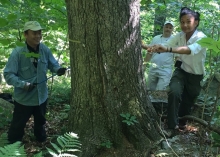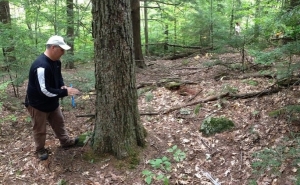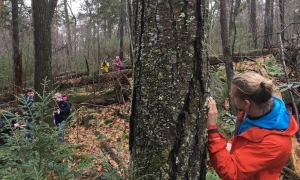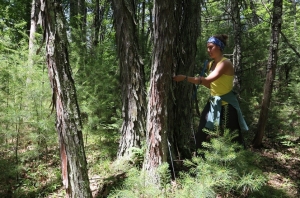You are here
New Grant: Redefining the Ecological Memory of Forest Disturbance

A new, 4-year grant from the National Science Foundation to HF Senior Ecologists Neil Pederson and Dave Orwig will support an unprecedented inquiry into 600 years of tree growth data from 35 old-growth forest study sites in the Northeast. The research will test the sensitivity of Northeast forest ecosystems to extreme climate events such as drought or late-spring frosts.
Preliminary evidence suggests that tree-killing climatic events like these have historically shaped our region’s forests across wide geographic scales, leaving legacies that last centuries. But these wide-reaching disturbances are rarely represented in the climate models scientists use to make predictions about future forest change. By scaling from seasons to centuries, the scientists say, this project bridges short- and long-term studies to provide information at the scales necessary to guide land-use decisions in complex systems under a changing climate.
In addition to scientific products like amassing a database containing around 1.5 million growth rings, at least 500 years of disturbance history, and wall-to-wall dynamic maps of ecological memory, this project will support half a dozen undergraduate student internships, a post-doctoral fellowship, and a multi-summer research experience for a public school teacher to create lesson plans that will be freely distributed in future workshops for teachers.
- Read the full project abstract.
- Learn more about the work of the Harvard Forest Tree Ring Lab.
- Explore key papers from this work in Ecological Monographs and a dendroecology book (1, 2)
Photographs
(click image for high-res)
 Dr. David Orwig coring a northern red oak in southwestern New Hampshire that dates to the 1780s. This population of oak gave more evidence supporting earlier observations that some tree-killing event stimulated tree recruitment around the Northeast in the late 1700s (Pederson et al. 2017). Photo by Neil Pederson.
Dr. David Orwig coring a northern red oak in southwestern New Hampshire that dates to the 1780s. This population of oak gave more evidence supporting earlier observations that some tree-killing event stimulated tree recruitment around the Northeast in the late 1700s (Pederson et al. 2017). Photo by Neil Pederson.
 The Harvard Forest Tree Ring Lab Team establishes plots in an old-growth forest in northern New Jersey in November, 2018. While the oldest trees in this forest date to the late 1500s, the northern red oak and trees of other species make a small cohort of recruitment in the late 1700s (Pederson et al., 2017). Photo by Neil Pederson.
The Harvard Forest Tree Ring Lab Team establishes plots in an old-growth forest in northern New Jersey in November, 2018. While the oldest trees in this forest date to the late 1500s, the northern red oak and trees of other species make a small cohort of recruitment in the late 1700s (Pederson et al., 2017). Photo by Neil Pederson.

Sophie Pitney, 2019 Summer Research Program student, cores a shagbark hickory at the Harvard Forest, near the species' northern range margin. Photo by Neil Pederson.
Image at top of screen: The Harvard Forest Tree Ring Lab Team cores a tree to update the ages of northern red oak trees in an old-growth forest in upstate New York. From L to R, Dr. Zhen-ju Chen of Shenyang Agricultural University, Dr. David Orwig, and Mel Paduani, 2017 HF Summer Research Program student. The northern red oak population here is multi-aged, but contains a cohort of trees that also date to the late 1700s (Orwig et al. 2001). Photo by Neil Pederson.

